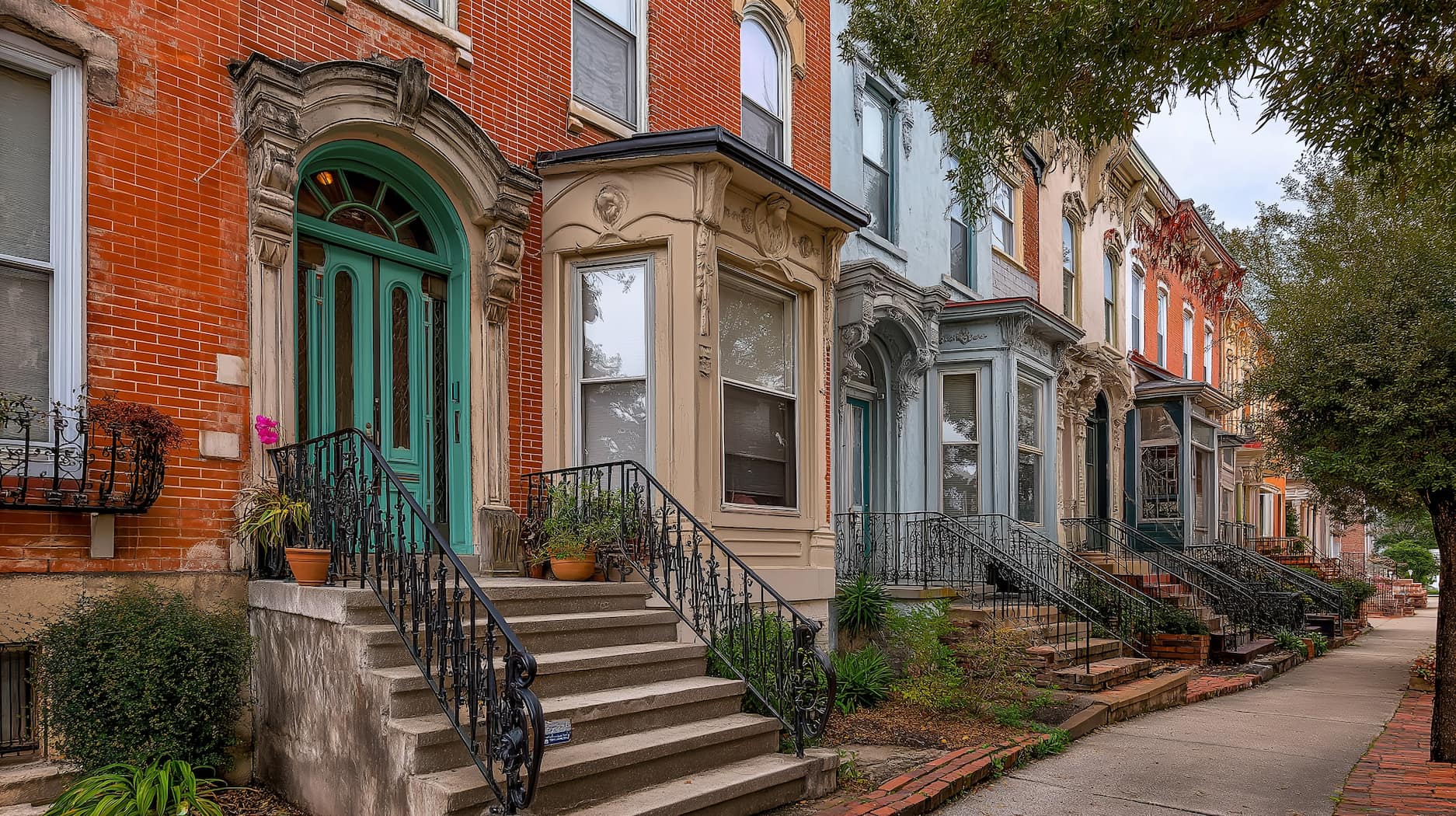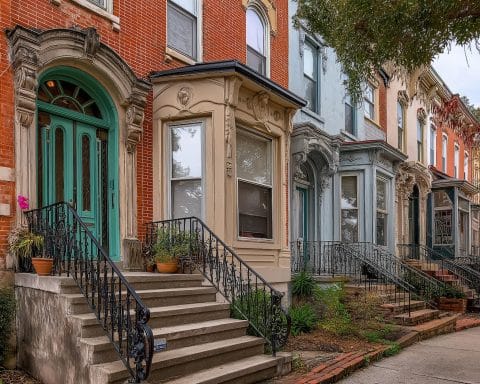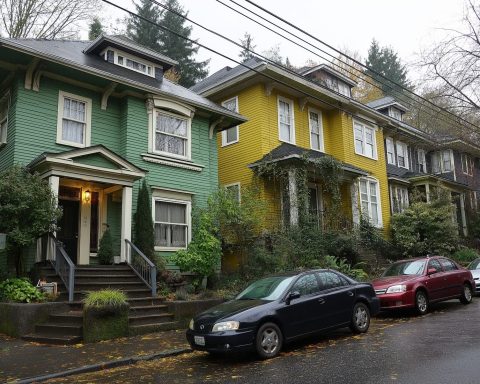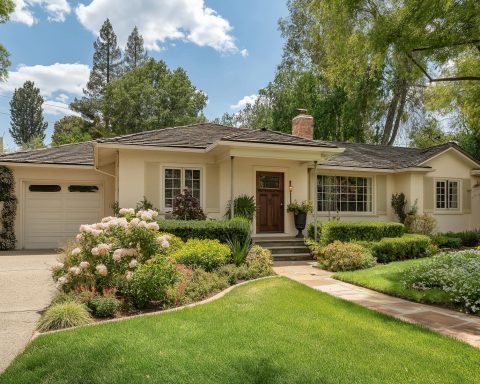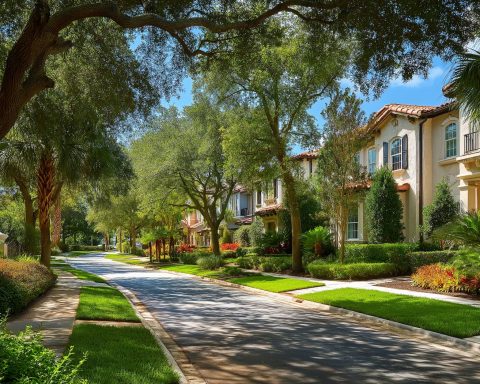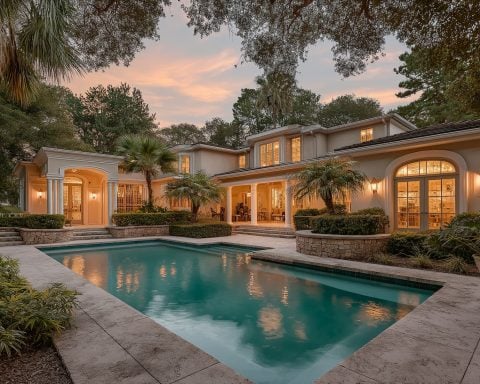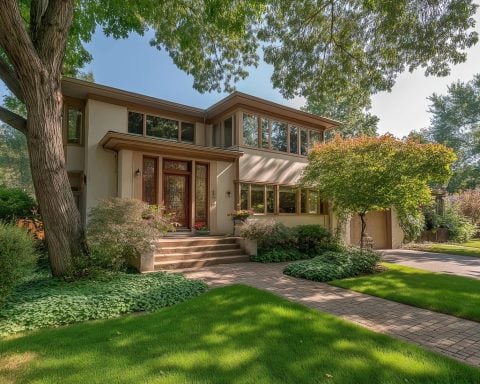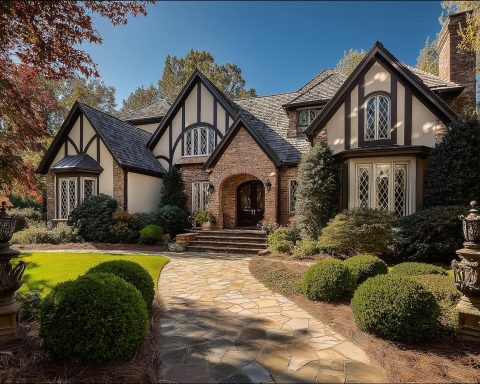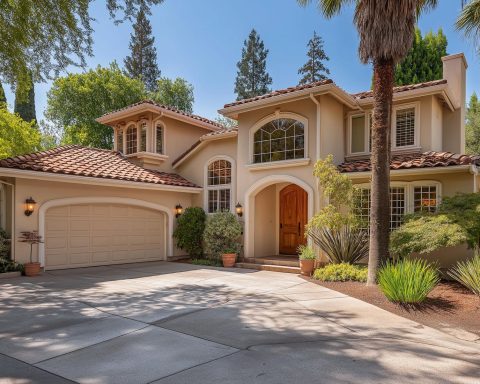Baltimore’s real estate market in 2025 is full of contrasts: resilient residential demand despite higher interest rates, a commercial sector finding its footing post-pandemic, and transformative developments reshaping the city’s landscape. In this report, we break down the state of Baltimore real estate across all sectors – from surging rents and tight housing supply to major waterfront projects and forecasts through 2030 – with insights from experts and local data.
Residential Real Estate Trends in 2025
Home Prices and Sales: Baltimore’s housing market has cooled from the frenzy of 2021–2022 but remains stable with modest price growth. The typical home value in the city is around $189,000, up slightly (about +0.6% year-over-year as of mid-2025) zillow.com zillow.com. Median sale prices are higher (around $225,000 in mid-2025) since move-in-ready homes in desirable areas still fetch strong offers zillow.com. No significant price declines are evident – in fact, many neighborhoods are still seeing prices inch up, just not at the double-digit pace of the pandemic boom years leetessier.com leetessier.com. According to an average of major forecasters, home values are expected to rise about 1.5–2% in 2025, signaling a gentle upward trend rather than any crash leetessier.com. Inventory remains historically low, which props up prices: only about 2,700 homes were on the market in the city in mid-2025 zillow.com, and listings go under contract in just 19 days on median zillow.com zillow.com – a sign that well-priced homes still get snapped up quickly.
Housing Supply and New Developments: The supply of homes for sale has been constrained by years of under-building and reluctant sellers, creating a persistent inventory squeeze. Many existing homeowners with ultra-low mortgage rates are holding off selling, keeping resale supply tight. On the new construction front, Baltimore is seeing a surge in multifamily development. Nearly 4,000 new apartment units were delivered in Q1 2025 alone, yet renter demand kept up such that vacancy fell rather than rose bpmngmt.com. Several large residential projects are underway or recently opened – for example, the Baltimore Peninsula (Port Covington) development began delivering its first homes in 2024, including the Locke Landing project which will bring over 800 new homes (townhouses, condos, and apartments) over the next 3–4 years sobopost.org. Mixed-income housing redevelopments are also in progress; the Perkins Somerset Old Town (PSO) Transformation Plan on the east side is replacing old public housing with new mixed-income communities (over 550 units in the first phase) along with a new school and amenities, a project that will ultimately impact about 6,000 residents in those neighborhoods baltimoretogether.com. These developments aim to boost housing inventory, but demand still exceeds supply – meaning 2025’s market continues to favor home sellers.
Rental Market Strength: The rental market is running hot in 2025, with high demand and steadily rising rents. Baltimore City’s average rent is about $1,624 per month, just below the U.S. average, with year-over-year rent growth of roughly +0.8% – enough to keep pace with inflation while remaining affordable relative to other cities bpmngmt.com bpmngmt.com. In the broader metro area, rents have climbed about 3.3% since January 2024 bpmngmt.com. Importantly, vacancy rates have ticked down for the first time since 2021, now around 7.9% citywide bpmngmt.com. In-demand areas like Canton, Federal Hill, and Fells Point command premium rents (around $2,000–$2,400 for a typical apartment) thanks to their waterfront locations and nightlife bpmngmt.com bpmngmt.com. Even the influx of new apartments hasn’t softened the market – strong absorption has kept vacancies low, a clear sign of resilient renter demand bpmngmt.com. Landlords thus have improved pricing power, and many are optimizing rents and offering modern amenities to capitalize on the tight market. Overall, Baltimore’s rental sector in 2025 is healthy and competitive, providing solid returns for property owners as the city remains about 9% cheaper than the national average rent – an advantage attracting renters priced out of costlier metros bpmngmt.com bpmngmt.com.
Commercial Real Estate: Office, Retail, and Industrial
Office Market
Baltimore’s office sector is in a period of transition. Downtown office vacancy climbed to record highs during the pandemic and aftermath – reaching about 18–22% vacancy by 2023–2024 in the city’s business district cushmanwakefield.com bisnow.com – as companies downsized and remote/hybrid work curtailed demand. In 2025, the office market is slowly rebalancing. There are signs of stabilization: the overall Baltimore City office vacancy held around 22.4% in mid-2024, essentially flat year-over-year (the rapid vacancy increases have leveled off) cushmanwakefield.com. Landlords have responded to high vacancy with concessions and creative re-use of older space. One bright spot is a surge of government tenants filling downtown offices – the State of Maryland began relocating agencies from suburban offices into Downtown Baltimore, aiming to move 6,000 state employees into the central business district by end of 2025 godowntownbaltimore.com godowntownbaltimore.com. This initiative, backed by state funding, is backfilling some vacant towers and boosting foot traffic on weekdays. Still, office demand remains below pre-pandemic levels. Leasing activity has improved (gross leasing in 2023 was ~27% higher than the pandemic-era average) bisnow.com, but hybrid work is here to stay – office buildings, especially older Class B/C properties, are competing heavily for fewer full-time tenants. Top-tier Class A offices in areas like Harbor East and Harbor Point fare better (benefiting from new build-outs and waterfront amenities), while dated buildings struggle. To spur revival, city leaders are even pondering office-to-residential conversions and tax incentives. Headline office stats as of 2025 show a market in the doldrums but not collapsing: downtown vacancy ~22%, suburban Baltimore County office vacancy in the mid-teens (around 16–17%) cushmanwakefield.com, and rents generally flat after plateauing in 2022–2023. The outlook is cautiously optimistic that as the economy grows and more workers return (albeit on hybrid schedules), Baltimore’s office absorption will slowly improve. Notably, new marquee office projects are still moving forward – T. Rowe Price opened its new 550,000 sq. ft. global headquarters at Harbor Point in 2024 thedailyrecord.com, signaling confidence that modern, high-quality offices can thrive and draw major tenants even as older offices are repurposed.
Retail Sector
Baltimore’s retail real estate has been a mixed bag, with neighborhood-level successes and downtown challenges. Neighborhood retail strips and suburban shopping centers have largely recovered from pandemic lows – areas like Hampden, Canton, and Federal Hill report low retail vacancy as restaurants and boutique shops benefit from local spending and tourism. By contrast, the downtown Inner Harbor retail scene has struggled with store closures and lower foot traffic. The iconic Harborplace pavilions, once a bustling waterfront mall, became mostly vacant by the 2010s. However, big changes are ahead: a massive $1 billion Harborplace redevelopment is approved and slated to begin construction in late 2026 cbsnews.com cbsnews.com. Developer MCB Real Estate (led by Baltimore’s own David Bramble) will demolish the old pavilions and build a modern mixed-use complex – including a 4.5-acre publicly accessible park and amphitheater, new retail and dining space, and even a pair of residential towers with ~900 apartments cbsnews.com cbsnews.com. Zoning changes passed in 2024 removed height limits on the site to allow this dense development baltimorefishbowl.com. In the interim, the city and promoters are animating downtown with events (like the reopened CFG Bank Arena hosting concerts) to draw patrons back. Retail rents in Baltimore are relatively affordable (street retail in prime areas averages in the mid-teens per square foot annually), and vacancy for well-located retail space is below 5% in many submarkets mackenziecommercial.com. The outlook for retail is one of gradual improvement: as residential population grows downtown and big projects like Harborplace and Harbor East’s expansion materialize, retail demand is expected to rise. Additionally, Baltimore’s tourism rebounding (Orioles baseball success, conventions, etc.) should lift retail sales. By 2025, investors were cautiously bullish – retail property had positive momentum entering 2025 with below-average vacancy nationally, and Baltimore is riding that trend, especially for necessity-based retail and experiential dining that can’t be replicated online institutionalpropertyadvisors.com. In summary, retail is stabilizing, with transformative projects on the horizon poised to redefine the shopping and entertainment landscape of central Baltimore later this decade.
Industrial Sector
The industrial real estate sector in greater Baltimore has been a powerhouse in recent years, fueled by the region’s strategic location and port infrastructure. Warehouse, logistics, and flex space saw surging demand during the e-commerce boom, driving vacancies down and rents up. By 2025, there are signs of cooling off from the breakneck pace – but the market remains fundamentally strong. Metro Baltimore’s industrial vacancy rose to about 8.5% in Q2 2025, up 100 basis points from earlier in the year and the highest vacancy rate since 2020 cushmanwakefield.com. This uptick is partly due to a wave of new deliveries in 2023–24 and some macroeconomic uncertainty causing tenants to hit pause on expansions cbre.com. Only two industrial lease deals over 200,000 sq. ft. were signed in the first half of 2025, compared to an average of 10 such big deals in comparable periods of recent years cbre.com. Net absorption turned slightly negative in early 2025 (about 46,000 sq. ft. net occupancy loss year-to-date by midyear) – the first softening in a decade cbre.com cbre.com. Despite these headwinds, demand drivers remain solid: nearly 100 tenants were in the market for space across the region, and overall leasing volume actually rose ~17% quarter-over-quarter in Q2 (driven mostly by renewals) cbre.com cbre.com. The Port of Baltimore and Tradepoint Atlantic continue to be magnets for industrial growth. Tradepoint Atlantic, the 3,300-acre logistics campus at Sparrows Point, is now home to over 20 major tenants including Amazon, FedEx, Home Depot, Under Armour, Volkswagen and others gdcoc.org. New facilities (warehouses, distribution centers, and even a potential new container shipping terminal) are in the pipeline, ensuring Baltimore remains a key Mid-Atlantic distribution hub. Industrial rents are at record highs (around $8–$10 per sq. ft. triple-net for modern warehouse space) after surging nearly 69% since 2015 nmrk.com. The slight rise in vacancy is giving tenants a bit more bargaining power, and rent growth has cooled to the low-single-digits annually, but no major oversupply is expected. In fact, 2025 deliveries are on track to be less than half of 2023 levels cbre.com, which should help balance the market. All told, the industrial sector’s outlook is steady: after a breather in 2025 due to economic uncertainty and higher interest rates, demand is expected to pick back up in coming years, bolstered by Baltimore’s port advantages and its emerging role in distribution, life-sciences manufacturing, and even data centers (which the Baltimore Peninsula project is now considering in its next phase) southbmore.com.
Buyer vs. Renter Market Dynamics
The dynamics between buying vs. renting in Baltimore have shifted notably in the face of rising interest rates and post-pandemic economic changes. For many residents, renting is currently more affordable than owning, which is influencing housing choices. Nationally, the total monthly cost of owning a median-priced home (including mortgage, taxes, maintenance, insurance) has jumped about 64% in four years, to roughly $3,800 per month, due to higher rates and expenses wtop.com wtop.com. Meanwhile, the cost to rent a typical single-family home rose only ~16% in that period, to about $2,236 per month wtop.com wtop.com. This means owning a home can cost ~70% more per month than renting the equivalent home in 2024 wtop.com wtop.com. Baltimore follows this trend: with 30-year mortgage rates hovering around 6.5–7%, many would-be buyers find that their potential mortgage payment far exceeds local rents. As a result, a segment of households has delayed purchasing and remained renters, bolstering rental demand (as reflected in Baltimore’s falling rental vacancies and rent uptick) bpmngmt.com bpmngmt.com. Property managers note that rising home prices and interest costs are “pushing more people to rent,” especially younger professionals who might have bought condos a few years ago but now opt to rent in high-demand areas like Canton or Fed Hill bpmngmt.com bpmngmt.com.
At the same time, the for-sale market is in a stand-off: sellers still have the upper hand in many transactions due to limited inventory (well-priced homes often get multiple offers at or above list price – about 39% of Baltimore sales in mid-2025 closed over asking zillow.com zillow.com). But buyers have become more cautious and price-sensitive, given high borrowing costs and economic uncertainty. This has led to longer search times and fewer bidding wars than in 2021, and buyers frequently negotiate repairs or seller concessions now. Essentially, 2025 feels closer to a balanced market than the frenzied seller’s market of the recent past. In some months, Baltimore has even seen slight increases in housing inventory and days on market, sparking debate about a possible tip toward a buyer’s market – but any such shift is very localized and modest. Overall, buyers hoping for big price drops continue to be disappointed, as prices are holding steady or climbing slowly instead of falling leetessier.com leetessier.com. For those who can afford to buy, the environment rewards patience and preparation: pre-approved, well-informed buyers can succeed if they act quickly on desirable listings, given that the median time to pending is under three weeks zillow.com.
Investor activity is another factor in the mix. Baltimore’s relatively low home prices (median ~$224K, roughly half the national median) baymgmtgroup.com and strong rental demand make it attractive for real estate investors. Both local and out-of-state investors have been purchasing rowhomes and small multifamilies to turn into rentals. This investor interest further bolsters the renter market, as a significant share of Baltimore’s housing stock is non-owner-occupied. In 2024, Baltimore was noted as a good market for rental investing due to its large student and medical worker population (multiple universities and hospitals ensure a steady tenant pool) and steady job market baymgmtgroup.com baymgmtgroup.com. The presence of investors can make it tougher for first-time homebuyers in some neighborhoods (as investors often pay cash or outbid with higher offers), but it also means a robust supply of rental homes. About half of Baltimore’s households rent rather than own, and that ratio may increase slightly if high mortgage rates persist. City leadership is mindful of this dynamic; policies like expanding first-time buyer assistance and funding affordable housing aim to keep homeownership within reach even as market pressures nudge more people into renting.
Investment Opportunities & Up-and-Coming Neighborhoods
Baltimore is often called a “city of neighborhoods,” and indeed neighborhood-level trends drive investment opportunities. As we head through 2025, several areas stand out as up-and-coming hot spots for real estate:
- Waterfront Neighborhoods (Federal Hill, Canton, Fells Point): These historically popular areas in South and East Baltimore remain magnets for young professionals and investors. They combine historic charm with new development and have seen continued gentrification and rent premiums in 2025 bpmngmt.com. Federal Hill’s lively restaurant/bar scene and proximity to Downtown keep demand high – the average home price there is around $330K, and typical rents exceed $2,100 baymgmtgroup.com baymgmtgroup.com. Canton and Fells Point, with their waterfront parks and boutiques, command some of the city’s highest rents (median ~$2,300 in Canton) baymgmtgroup.com baymgmtgroup.com. These neighborhoods are still appreciating but at a moderate pace, making them solid choices for investors seeking long-term growth and reliable tenants. New luxury townhomes and apartment projects in these areas (e.g. along Key Highway or Brewer’s Hill) add to the supply, yet occupancy remains high.
- Mount Vernon & Station North: Mount Vernon, Baltimore’s cultural heart, is known for its classic architecture and institutions (museums, universities). It’s increasingly on investors’ radar for value-add multifamily opportunities – the area is affordable (average home price ~$223K) baymgmtgroup.com yet attracts a steady renter population of students and young professionals. Nearby Station North (Charles North/Greenmount West) has blossomed into an arts and entertainment district with new apartments and rehabbed rowhomes drawing in creatives. Prices in these central neighborhoods are still reasonable relative to their potential, making them promising “buy low, rent high” locales.
- Emerging Areas (Remington, Pigtown, Highlandtown): Outside the traditional hot spots, a number of formerly overlooked neighborhoods have momentum. Remington, for example, has transformed with trendy food halls (R. House), start-up offices, and apartments developed by Seawall – spurring home renovations in the surrounding blocks. Pigtown (Washington Village), close to the stadiums and the new University of Maryland BioPark expansion, is seeing investors flip shells into modern rentals. And Highlandtown/Brewer’s Hill in East Baltimore, a diverse community with a growing arts scene, has become a bargain alternative to Canton – expect continued appreciation there as new retail (like the Yard 56 complex) and residential projects come online. Investors looking for the next Canton are keeping an eye on these areas just on the cusp of broader discovery.
- Baltimore County and Suburbs: The city’s suburbs also offer opportunities, especially for those interested in rental properties serving families and commuters. Areas like Towson, Catonsville, and Parkville boast good schools and remain in high demand. Towson, for instance, has rents around $1,850 and a strong student tenant base from Towson University bpmngmt.com bpmngmt.com. With more companies adopting hybrid work, suburbs with easy city access could see increased housing demand from those seeking space and flexibility, making suburban single-family rentals or fix-and-flip homes a viable investment play.
In summary, investors have plenty of options in Baltimore – from high-end waterfront condos to blue-collar rowhouses ripe for rehab. Key factors to consider are neighborhood trajectory (is the area improving?), rental demand (proximity to jobs/colleges), and relative affordability. Baltimore’s growing neighborhoods list often features the likes of Federal Hill, Canton, Fells Point, Mount Vernon, and even upscale Roland Park for luxury rentals baymgmtgroup.com baymgmtgroup.com. Each offers a different risk/reward profile. The common thread is that Baltimore’s real estate values, while rising, are far below Washington D.C. or NYC levels, which suggests room for growth. The city’s initiatives in revitalization (e.g. grants for homebuyers in certain neighborhoods and the aforementioned zoning reforms) could unlock new opportunities in long-neglected areas as well. For example, the large-scale Perkins Homes redevelopment near Little Italy will over the next few years create mixed-income housing and retail where barracks-style projects once stood, likely boosting property values in adjacent Harbor East and Upper Fells Point. Early investors in these transitioning zones could benefit significantly if these projects succeed.
Policy Changes and Zoning Developments
Recent policy changes and zoning reforms are poised to significantly influence Baltimore’s real estate market by encouraging development and increasing housing supply. In May 2025, Mayor Brandon Scott introduced a sweeping legislative package called the Housing Options and Opportunity Act – five zoning bills designed to make housing “more abundant and affordable” across the city foxbaltimore.com foxbaltimore.com. These bills propose rolling back exclusionary zoning rules that have constrained housing density. Notably, one bill (No. 25-0066) will allow construction of small-scale multifamily housing (up to 4 units) in residential zones that were previously limited to single-family homes foxbaltimore.com foxbaltimore.com. This effectively legalizes duplexes, triplexes, and fourplexes in many areas, creating opportunities for gentle infill density and diversifying housing types. Another bill eliminates off-street parking requirements, which have often added cost and complexity to urban projects foxbaltimore.com foxbaltimore.com. Removing mandatory parking minimums can enable developers to build on smaller lots and lower the cost per unit, hopefully leading to more affordable apartments. Additionally, the reform package addresses some quirky building code rules (like requiring two staircases in buildings over three stories); one change will allow up to 6-story buildings with a single stairwell, aligning Baltimore’s code with common international standards to reduce construction costs foxbaltimore.com foxbaltimore.com. These zoning updates, once passed and implemented, are expected to spur new multifamily development, especially in neighborhoods with good infrastructure that were previously “locked” into single-family-only use. The emphasis is on reversing decades of “racist exclusionary zoning” and increasing equity by opening up more communities to different housing. In short, Baltimore is embracing a more pro-development stance in 2025, betting that a more flexible zoning code will lead to more housing options and lower rents in the long run.
Beyond zoning, other policy initiatives are shaping the real estate environment. The city has expanded incentives for development in certain areas – for example, continued use of Tax Increment Financing (TIF) to support big projects like the Port Covington/Baltimore Peninsula development. Historic tax credits remain available for rehab of the city’s many historic buildings, which is key to financing renovations in neighborhoods like West Baltimore. There’s also a focus on tackling the city’s notorious vacant property issue: the state and city formed a Baltimore Vacants Initiative in 2023 to coordinate funds and programs for rehabilitating or demolishing blighted properties news.maryland.gov news.maryland.gov. A related effort is Project C.O.R.E. (Creating Opportunities for Renewal and Enterprise) which has been ongoing, removing hundreds of derelict houses and preparing land for new uses. All of this affects the market by potentially freeing up land for development and improving neighborhood conditions (and thus property values).
On the downtown commercial front, one unique policy move has been the relocation of state government offices to Downtown Baltimore, as mentioned earlier. With support from former Governor Larry Hogan and continued under Governor Wes Moore, Maryland has budgeted tens of millions for this effort godowntownbaltimore.com godowntownbaltimore.com. By late 2025, over 5,000 state employees will have moved into leased offices in the Central Business District, filling large chunks of office buildings godowntownbaltimore.com godowntownbaltimore.com. This is effectively an economic development policy to stabilize downtown real estate: more workers means more demand for downtown apartments, lunch spots, and transit – a virtuous cycle the city sorely needs to revive its core.
Finally, Baltimore County’s Master Plan 2030 (in the suburban county surrounding the city) and the city’s own comprehensive plan update (dubbed “Our Baltimore”) provide a roadmap for land use over the next decade. While these are high-level policy guides, they emphasize mixed-use development, transit-oriented growth, and sustainable practices. Notably, Baltimore City’s plan calls for adding thousands of new housing units by 2030 and concentrating development around transit lines and job hubs, which dovetails with the zoning changes underway. All these policy measures – zoning reform, incentives, strategic relocations – aim to make Baltimore a more investment-friendly environment and address long-standing challenges like housing affordability and vacant blight. The real estate community is watching closely to see how quickly these changes translate into real projects on the ground.
Demographic and Economic Factors Influencing Supply & Demand
Underlying Baltimore’s real estate trends are the demographic and economic currents of the region. A critical factor is the city’s population trajectory. For decades, Baltimore City saw population decline, losing residents to suburbs or other states. However, recent data offers a glimmer of hope: between 2023 and 2024, Baltimore’s population inched up for the first time in years. Census estimates show the city gained about 750 people, bringing the population to approximately 568,300 in mid-2024 foxbaltimore.com youtube.com. While modest, this stabilization is touted by officials as a sign that Baltimore may be turning the corner on out-migration. The metro area (Baltimore-Columbia-Towson MSA) as a whole has around 2.8 million people and continues to grow slowly iemergent.com iemergent.com, even as the city proper had been shrinking. If Baltimore City can sustain population growth (even at ~0.1% annually), it will bolster housing demand for both rentals and home purchases, and improve investor confidence.
Demographics: Baltimore has a diverse population, but also faces socio-economic challenges. The city’s median household income is relatively low – Baltimore ranks 87th out of the 100 largest U.S. cities in median income, and roughly 20% of residents live below the poverty line planning.baltimorecity.gov. This means a significant portion of the housing demand is for affordable and workforce housing. Developers and policymakers are working to ensure new projects include affordable units (e.g. through inclusionary housing requirements or Low-Income Housing Tax Credit projects), especially since rising rents can otherwise price out long-time residents. At the same time, there’s an influx of young professionals and students in certain areas, creating micro-markets of higher-income renters/buyers (for example, the population in downtown and waterfront neighborhoods skews younger and more affluent). The homeownership rate in the metro area is about 67% iemergent.com iemergent.com, but within the city it’s much lower (closer to 45%–50%). There’s a concerted push to raise Black and Hispanic homeownership rates, which lag far behind White homeownership in Baltimore iemergent.com iemergent.com – bridging this gap could unlock new buyer demand if lending and outreach programs succeed in the coming years.
Economic drivers: Baltimore’s economy underpins its real estate health. The region’s largest employers include healthcare and education (“eds and meds”), government, financial services, and logistics. Anchors like Johns Hopkins University and Hospital (the city’s top employer), University of Maryland Medical Center, and Loyola/Notre Dame, not only employ tens of thousands but also draw students and researchers – all of whom need housing. This is why areas around these institutions (e.g. Johns Hopkins Homewood in Charles Village, and the area around Hopkins Hospital/Eager Park) have steady housing demand. The metro also has a sizable federal presence (social security administration, NSA at Fort Meade nearby) and a growing tech and cybersecurity sector. Unemployment in Maryland has remained relatively low (in the 4% range in 2023–25), and job growth has been steady, if unspectacular. Notably, port-related and logistics jobs are expanding thanks to the Port of Baltimore’s booming shipping business and Tradepoint Atlantic’s growth. For instance, new distribution centers at Tradepoint are bringing hundreds of blue-collar jobs, which in turn supports housing markets in Baltimore County and southeast city neighborhoods.
Baltimore’s quality of life factors do play a role in real estate demand as well. Crime and public school quality are perennial concerns often cited by those who leave the city. Reducing violent crime has been a focus of the current administration, and while 2023–2024 saw some improvement (homicides slightly down), the city recognizes that safety and perception influence whether families choose to live in the city or opt for the counties. Progress on this front could encourage more residents to stay and invest in city neighborhoods, boosting home values. Similarly, investments in transit (like the planned Red Line East-West transit route revival) and infrastructure could open new areas for development and make commuting easier, affecting where housing demand grows.
In summary, demand in Baltimore’s real estate market is a tale of two cities: one driven by an influx of young professionals, students, and empty-nesters attracted to urban living (fueling luxury apartments and rehabbed townhomes in gentrifying areas), and another driven by the existing working-class population that needs affordable homes and rents. Economic and demographic trends – stable employment, a possible stabilization of population, and initiatives to increase incomes and homeownership – all point toward slow but positive momentum. If Baltimore can capitalize on its strengths (education, healthcare, port/logistics, affordability relative to DC/Philly) and address its challenges, the demand for housing and commercial space can only grow over the next decade.
Market Forecasts for 2025–2030
Looking ahead, experts project Baltimore’s real estate market to experience moderate, sustainable growth from 2025 through 2030, rather than the roller-coaster swings of the past decade. Housing economists foresee a period of flattening then gradual increases in home prices. Nationally, home values are expected to rise at a slower pace – roughly on the order of 3-4% per year over the next five years redfin.com – and Baltimore’s affordable market may see similar or slightly lower appreciation. In the near term, 2025’s forecast (as noted earlier) is around +1–2% price growth for Baltimore-area homes leetessier.com, given the headwinds of high interest rates. By 2026–2027, if inflation eases and mortgage rates come down a bit, sales activity could pick up again, bringing more buyers into the market and slightly higher annual price gains (perhaps mid-single-digit percent increases). However, no major price spikes are expected; rather, the consensus is for “flatter price increases” and more balanced conditions realestate.usnews.com. This would be a welcome contrast to the double-digit jumps seen in 2021, keeping Baltimore housing relatively affordable and reducing the risk of a bubble. In fact, some national forecasts (e.g. Zillow) even predicted a brief dip in prices in 2025 (on the order of a few percent) before growth resumes fastcompany.com, though local experts largely disagree that Baltimore will see any full-year price declines barring a recession.
One big factor in the forecast is the trajectory of mortgage rates. Current projections show 30-year mortgage rates likely staying in the mid-6% range through 2025 leetessier.com, with potential to ease to closer to 5% by 2026–2027 if the Federal Reserve achieves a soft landing on inflation. Should rates indeed fall in the latter half of the decade, Baltimore could see an uptick in first-time buyers rushing back in, boosting sales volumes. Housing supply will also dictate outcomes – if the city’s zoning reforms and development incentives successfully produce more housing units (both for sale and rent), that could help keep prices/rents from overheating even as demand grows.
On the commercial side, the 2025–2030 outlook varies by sector. Office space is expected to recover slowly; forecasts from firms like JLL and Newmark suggest Baltimore’s office vacancy will remain elevated for a few years, then gradually improve as obsolete office stock is removed or repurposed and as companies adjust to hybrid work patterns. We might see the office vacancy rate drift down from ~20% closer to a healthier 15% by the end of the decade, assuming no new shock to office demand. Rent growth in office is likely to be minimal in the near term, with landlords focused on retention – any rent increases will be heavily concentrated in top-tier properties with unique offerings. Industrial real estate should regain momentum as early as 2026 – after the slight lull in 2025, the combination of e-commerce growth, port traffic increases, and Baltimore’s emergence as a mid-Atlantic distribution node is forecast to drive new leasing. Industry analysts expect industrial vacancies to tighten again by 2027 and rent growth to continue (though at single-digit annual rates) given the high cost of new construction and strong demand for modern logistics facilities. The pipeline of industrial development at Tradepoint Atlantic, for example, extends through the end of the decade with millions of square feet planned, indicating confidence in future demand.
For the multifamily (rental) market, forecasting firms like CoStar and Yardi project steady rent growth in Baltimore through 2030, roughly 2-3% per year on average, assuming the economy avoids major recession. Vacancy rates might rise slightly as the wave of new deliveries continues (with thousands more units planned downtown and in Harbor East/Little Italy), but as of 2025 absorption has kept pace and that trend is expected to continue given Baltimore’s relatively low rents regionally. In essence, Baltimore is likely to remain a landlord’s market in many respects – barring overbuilding, demand from renters should keep occupancy high. An important wildcard will be income growth: if Baltimore-area wages rise (perhaps due to growth in tech or if the city attracts new employers), that could provide capacity for higher housing costs and thus support the market. Conversely, if the population were to stagnate or decline again, that could soften demand. At this point, most experts are cautiously optimistic that the city’s population will hold steady or grow slightly thanks to revitalization efforts, meaning housing demand will be there for the new supply coming online.
To put some numbers on the long-term forecast: iEmergent’s mortgage market analysis for Baltimore projects that from 2023 to 2026, the total dollar volume of home purchase loans will increase ~4.3%, reflecting higher prices, but the number of transactions will actually fall (from about 29,000 home purchase loans in 2023 to 26,800 in 2026) iemergent.com iemergent.com. This implies that while each home will be pricier on average (due to appreciation), fewer homes will be changing hands – a trend consistent with an aging housing stock and lower mobility. By the late 2020s, if interest rates normalize lower, we could see sales volumes pick up again (more buyers entering the market), perhaps returning to ~30,000 purchase loans annually or more. Price appreciation is expected to be subdued but positive, so by 2030 Baltimore’s median home price might be, for example, 10–15% higher than in 2025 (accumulated over five years). For rents, a similar moderate rise is likely; renters could be paying perhaps 15% more in 2030 than they do today, assuming current trends, though this will vary by submarket and unit type.
In short, the 2025–2030 Baltimore real estate outlook is one of measured growth. The market is transitioning from a period of frenetic activity and sharp swings, into a phase of maturation and stability. Opportunities will favor the well-prepared: savvy investors and homebuyers who take a long-term view can benefit from Baltimore’s relatively high yields and lower entry prices, while developers who align projects with the city’s growth nodes and policy incentives should find a supportive environment. Barring unforeseen economic shocks, Baltimore in 2030 is projected to be a bit larger in population, with a revitalized downtown, more housing units, and a real estate market that, while not red-hot, is steadily climbing and significantly transformed from what it was in 2020.
Notable Real Estate Companies, Developers, and Projects Shaping the Landscape
Several key developers, companies, and flagship projects are actively reshaping Baltimore’s real estate landscape in 2025 and the coming years:
- Baltimore Peninsula (Port Covington) – Developed by MAG Partners/MacFarlane Partners and partners: This is one of the most ambitious urban redevelopment projects in the U.S., converting 235 acres of former industrial waterfront in South Baltimore into a new mixed-use district. After years of planning and infrastructure work (aided by one of the nation’s largest TIF financings), the project’s first phase “Chapter 1” has delivered 1.1 million sq. ft. of space so far magpartners.com, including the Rye Street Market office/retail buildings, two apartment complexes (≈400 units, now about 50% leased sobopost.org sobopost.org), and a hotel. In 2024, the CFG Bank moved its headquarters into one of the new offices sobopost.org, and by late 2024 Under Armour’s new global headquarters, a 280,000 sq. ft. campus, topped out – 1,400 UA employees are expected to move in by early 2025 sobopost.org. The Baltimore Peninsula developers (led by CEO MaryAnne Gilmartin of MAG Partners) are planning subsequent phases that may include additional office towers, thousands more housing units, parks, and even potentially a soccer stadium or data centers in future phases southbmore.com. This project is effectively creating an entire new neighborhood, and if successful, it will shift Baltimore’s center of gravity southward. Real estate observers often cite Baltimore Peninsula as a bellwether – its success or challenges will influence perceptions of Baltimore’s market.
- Harbor Point & Harbor East – Developed by Beatty Development and Partners: Harbor East (developed largely by H&S Properties in the 2000s) and the adjacent Harbor Point (led by Beatty) form a thriving waterfront extension of downtown. Notable companies anchored here include Exelon Corp.’s regional HQ and various finance and law firms. In 2024, T. Rowe Price completed its move to a brand-new twin-building headquarters at Harbor Point thedailyrecord.com business.maryland.gov – a $278 million investment that underscores confidence in Baltimore. Beatty Development is also behind new luxury apartment towers (like 1405 Point and the new Liberty Harbor East) that cater to upscale renters. These developers have essentially built a high-end enclave with hotels, retail, and dining that draw tourists and affluent residents. The momentum at Harbor East/Point is expected to continue, with additional sites available for development (e.g., future phases may bring more residential towers or a life-science research building). The Harbor East area in particular has become a shopping/dining destination, and its success has attracted outside investors – for instance, global real estate firm Armada Hoffler invested in the area’s development. In sum, the Beatty and H&S teams have been pivotal in transforming Baltimore’s waterfront into a 24/7 neighborhood, boosting the city’s image and tax base.
- MCB Real Estate – David Bramble’s firm (Harborplace Redeveloper): MCB Real Estate is a locally based developer that made headlines by taking on the Harborplace redevelopment. After acquiring the failing Harborplace out of receivership in 2022, MCB spent two years crafting a master plan, which city voters approved in 2024. As noted, the plan involves demolishing the old 1980’s era pavilions and building a modern mixed-use complex with four new buildings (including a 32/25-story residential tower with ~900 units, and two 200,000 sq. ft. commercial buildings with retail and even a rooftop park) cbsnews.com cbsnews.com. David Bramble and his company are emerging as key city builders; their ability to execute this $1B project (slated to begin construction in 2026 cbsnews.com) will be crucial for downtown’s future. MCB is also involved in other projects, including neighborhood retail centers and affordable housing deals around the region. It’s worth noting that Bramble, as an African American developer leading such a high-profile project, is seen as a trailblazer in a city striving for inclusive growth.
- Weller Development (Port Covington’s initial developer) & Plank Industries: These were the original drivers of the Port Covington vision, backed by Under Armour founder Kevin Plank. Weller Development oversaw the early phases of infrastructure and the first wave of building at Port Covington (prior to MAG Partners stepping in to lead vertical development). While Weller has since scaled back its role, its work laid the groundwork for what is now Baltimore Peninsula. Plank’s Sagamore Spirit distillery and Rye Street Tavern also helped put the area on the map. Plank Industries continues to have a stake and influence in Baltimore’s development, from Port Covington to smaller projects like boutique hotels (e.g., Sagamore Pendry in Fells Point, developed in partnership with others a few years ago). Their ambition and capital injection into Baltimore have been a catalyst, even if the execution is now in new hands.
- Public-Private Partnerships in Affordable Housing: A number of development groups are partnering with city agencies to tackle housing redevelopment. For example, the Perkins Somerset Oldtown project mentioned earlier is a collaboration involving the Housing Authority of Baltimore City, commercial developers like Cross Street Partners, and nonprofits, leveraging a $30 million federal Choice Neighborhoods grant. Similarly, groups like Mission First Housing and Enterprise Homes have been active in building new mixed-income communities on former public housing sites (e.g., the new O’Donnell Heights phases in East Baltimore). These developers, while not always in headlines, are crucial in reshaping Baltimore’s housing fabric, aiming to replace blighted blocks with updated homes.
- Life Sciences and Tech Hubs: Baltimore’s emergence as a modest life-science hub has developers like Wexford Science & Technology (which built the 1.5 million sq. ft. Johns Hopkins Science + Technology Park in East Baltimore) and institutions like University of Maryland BioPark driving projects. A new BioPark building, 4MLK, is under construction on the west side, set to add 250,000 sq. ft. of lab and office space and attract 50–100 biotech companies when finished business.maryland.gov eda.gov. On the tech side, Port Covington’s plan includes an innovation hub for cybersecurity and tech startups (helped by a recent federal designation of a Baltimore Tech Hub). Companies and organizations like UpSurge Baltimore are working to grow the startup ecosystem, which could increase demand for funky office spaces and coworking hubs in neighborhoods like Fells Point, Federal Hill, and Station North. Real estate firms attuned to these sectors, such as South Duvall (a life-sciences-focused developer), will play a growing role in supplying lab and tech workspace.
- Notable Brokerages and Property Managers: Firms such as CBRE, JLL, Cushman & Wakefield, Newmark and local players like MacKenzie Commercial are heavily involved in Baltimore’s market, brokering major deals and publishing research that shapes investor sentiment. On the residential side, companies like Redfin and Zillow have increased their data presence, while large property managers like Bay Management Group (BayMGMT) and Harbor Stone Advisors handle thousands of Baltimore rentals and often publish insights (as we’ve cited) on market trends bpmngmt.com baymgmtgroup.com. While not “developers,” these companies influence which projects move forward (through financing and leasing) and how the market is perceived via their reports.
In conclusion, Baltimore’s real estate scene in 2025 is being molded by a combination of big visionary developments and granular neighborhood improvements. Developers like MAG Partners, MCB Real Estate, and Beatty Development are changing the skyline with multi-acre projects, while countless smaller investors and builders are rehabbing rowhouses and infill lots one by one. Public sector initiatives and private entrepreneurship are increasingly aligning, as seen with the state’s downtown relocation effort and the city’s zoning overhaul, which enjoy support from the business community. The remainder of the 2020s will be a pivotal time: these players and projects will determine whether Baltimore fully capitalizes on its assets – affordable cost of living, historic character, strategic location – to realize a thriving, inclusive real estate market. If early signs are any indication (e.g. the leasing momentum at new developments and the first population uptick in years), Baltimore’s outlook is turning positive. By 2030, the city’s skyline will feature new towers at Harborplace and Port Covington, its neighborhoods will house new residents drawn by opportunity, and the story of Baltimore real estate will be one of rebirth and steady growth – built on the foundation being laid right now in 2025.
Sources:
- Zillow Research, Baltimore MD Housing Market Overview (July 2025) zillow.com zillow.com
- Lee Tessier Team, 2025 Housing Market Forecast (Maryland) leetessier.com
- BPM Property Management, Baltimore Rental Market 2025 Report bpmngmt.com bpmngmt.com bpmngmt.com
- Bisnow News, Baltimore Office Vacancy Hits Record High bisnow.com bisnow.com
- Cushman & Wakefield, Baltimore MarketBeat Office & Industrial Q2 2024–Q2 2025 cushmanwakefield.com cushmanwakefield.com
- CBRE Research, Baltimore Industrial Figures Q2 2025 cbre.com cbre.com
- Downtown Partnership of Baltimore, State Center Relocation Update (2025) godowntownbaltimore.com godowntownbaltimore.com
- CBS News Baltimore, Harborplace Redevelopment Details (Aug 2025) cbsnews.com cbsnews.com cbsnews.com
- FOX Baltimore (via Baltimore Sun), Housing Opportunity Act Zoning Bills (May 2025) foxbaltimore.com foxbaltimore.com
- iEmergent Market Analysis, Baltimore’s Shifting Housing Landscape (Feb 2025) iemergent.com iemergent.com
- Bay Management Group, Baltimore’s Growing Neighborhoods (Sept 2024) baymgmtgroup.com baymgmtgroup.com baymgmtgroup.com
- WTOP News, Housing Market Predictions 2024–2029 wtop.com wtop.com
- U.S. Census Bureau / Baltimore Mayor’s Office, 2024 Population Estimate (Baltimore City) foxbaltimore.com foxbaltimore.com
- Baltimore City Dept. of Planning, Key Trends Report planning.baltimorecity.gov
- SouthBmore Peninsula Post, Baltimore Peninsula Development Update (Apr 2024) sobopost.org sobopost.org
- Harbor Point Development News, T. Rowe Price HQ Opening (2024) thedailyrecord.com business.maryland.gov
- EDA Grant Press Release, Baltimore BioPark Expansion business.maryland.gov
